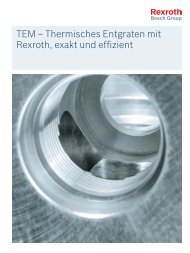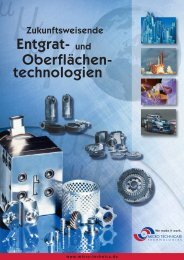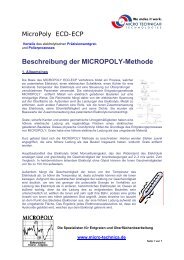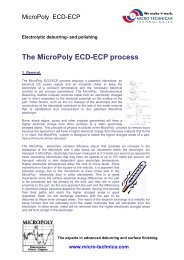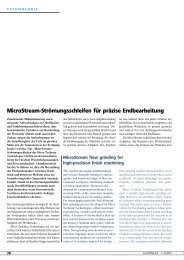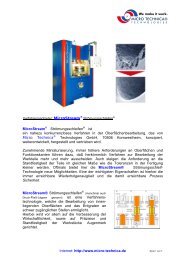TEM â Thermal Deburring from Rexroth â Precise and Efficient
TEM â Thermal Deburring from Rexroth â Precise and Efficient
TEM â Thermal Deburring from Rexroth â Precise and Efficient
You also want an ePaper? Increase the reach of your titles
YUMPU automatically turns print PDFs into web optimized ePapers that Google loves.
<strong>Deburring</strong> in seconds with<br />
<strong>TEM</strong> systems <strong>from</strong> <strong>Rexroth</strong><br />
With <strong>TEM</strong>, you can quickly <strong>and</strong> easily remove cutting burrs<br />
produced by turning, milling, broaching, <strong>and</strong> grinding, as<br />
well as burrs resulting <strong>from</strong> die-casting.<br />
How does <strong>TEM</strong> deburring work?<br />
The thermal deburring method is a thermal chemical pro-<br />
cess. The workpieces to be processed are placed in a pres-<br />
sure chamber that is then filled with a gas mixture <strong>and</strong><br />
ignited. Suitable combustible gases are hydrogen, methane,<br />
<strong>and</strong> natural gas.<br />
The temperature increases within milliseconds to between<br />
2500°C <strong>and</strong> 3000°C when the gas mixture is ignited. Due to<br />
their surface to volume ratio, the burrs on the workpieces<br />
absorb radiant heat that cannot be diverted into the interior<br />
of the workpiece. This results in an accumulation of heat<br />
that burns up the burr. The resulting oxide is deposited on<br />
the workpiece surface.<br />
Combustion principle of the<br />
thermal deburring process<br />
<strong>Deburring</strong> chamber<br />
Closure plate<br />
Effect of the gas mixture on the workpiece<br />
geometry. Burrs are burned up.<br />
Gas<br />
Oxygen<br />
Workpiece pre-treatment <strong>and</strong> after-treatment<br />
To prepare for <strong>TEM</strong> deburring, the workpieces must be<br />
washed <strong>and</strong> dried <strong>and</strong> not contain any grease. The oxide<br />
deposits produced during <strong>TEM</strong> can be easily removed by<br />
later washing, using acidic or neutral cleaning agents.<br />
1 2<br />
3<br />
<strong>TEM</strong> installation technology<br />
1 | Unmachined part<br />
2 | First machining<br />
step “deburring”<br />
3 | Machining step<br />
“Oxide reduction”<br />
The cylindrical deburring chamber is fixed in a solid machine<br />
frame. A rotary indexing table holding five closure plates is<br />
integrated in the machine. A hydraulic closing system lifts<br />
the respective closure plate with workpieces <strong>from</strong> the rotary<br />
indexing table <strong>and</strong> presses it against the deburring cham-<br />
ber, sealing it so no gas can escape. The gas <strong>and</strong> oxygen<br />
metered <strong>from</strong> two cylinders are forced through a mixing<br />
block into the chamber <strong>and</strong> then ignited by the ignition<br />
system. The deburring intensity can be controlled by the<br />
amount of supplied gas <strong>and</strong> the mix ratio of the gases. The<br />
workpieces are loaded <strong>and</strong> unloaded outside the sound<br />
protection enclosure during the machine cycle.



